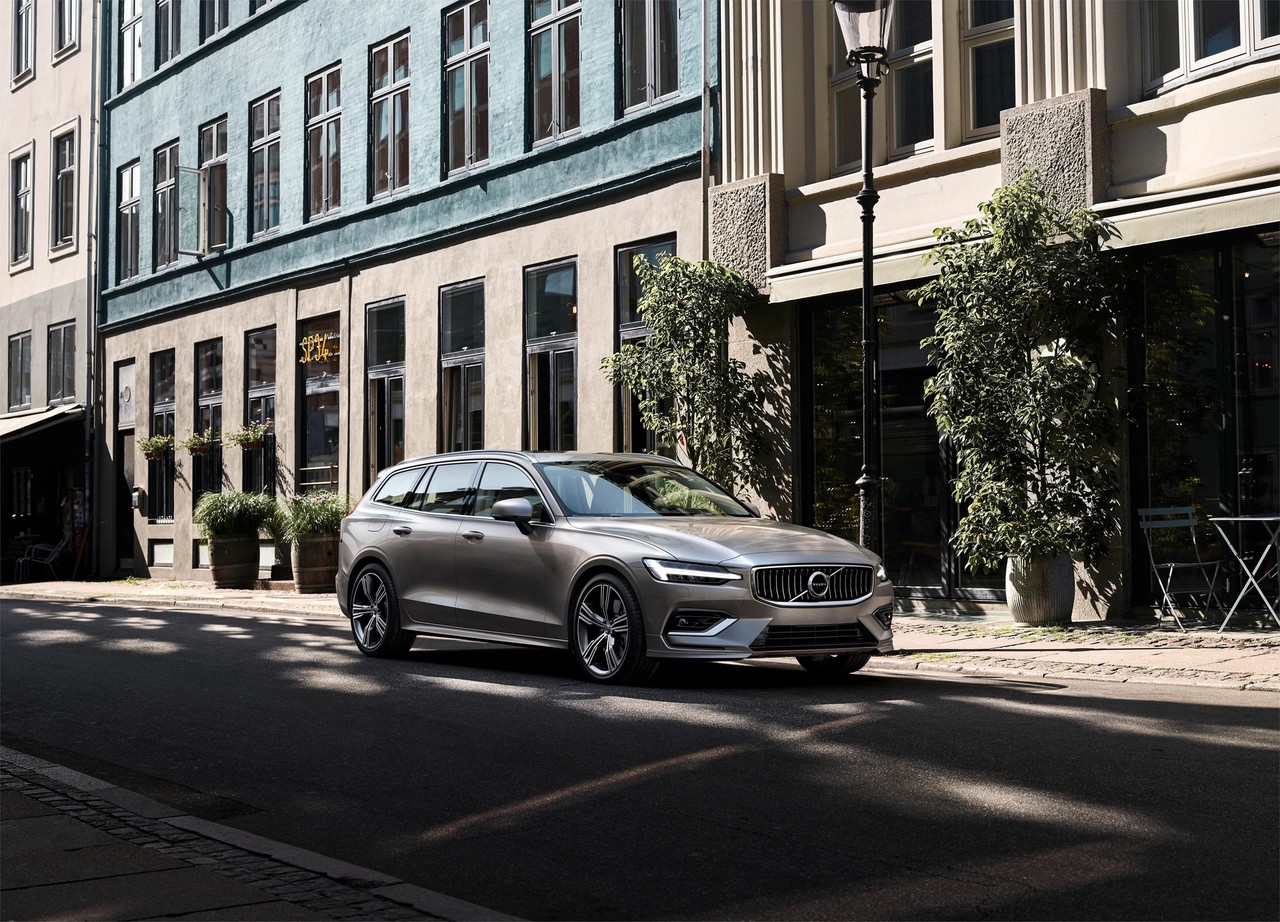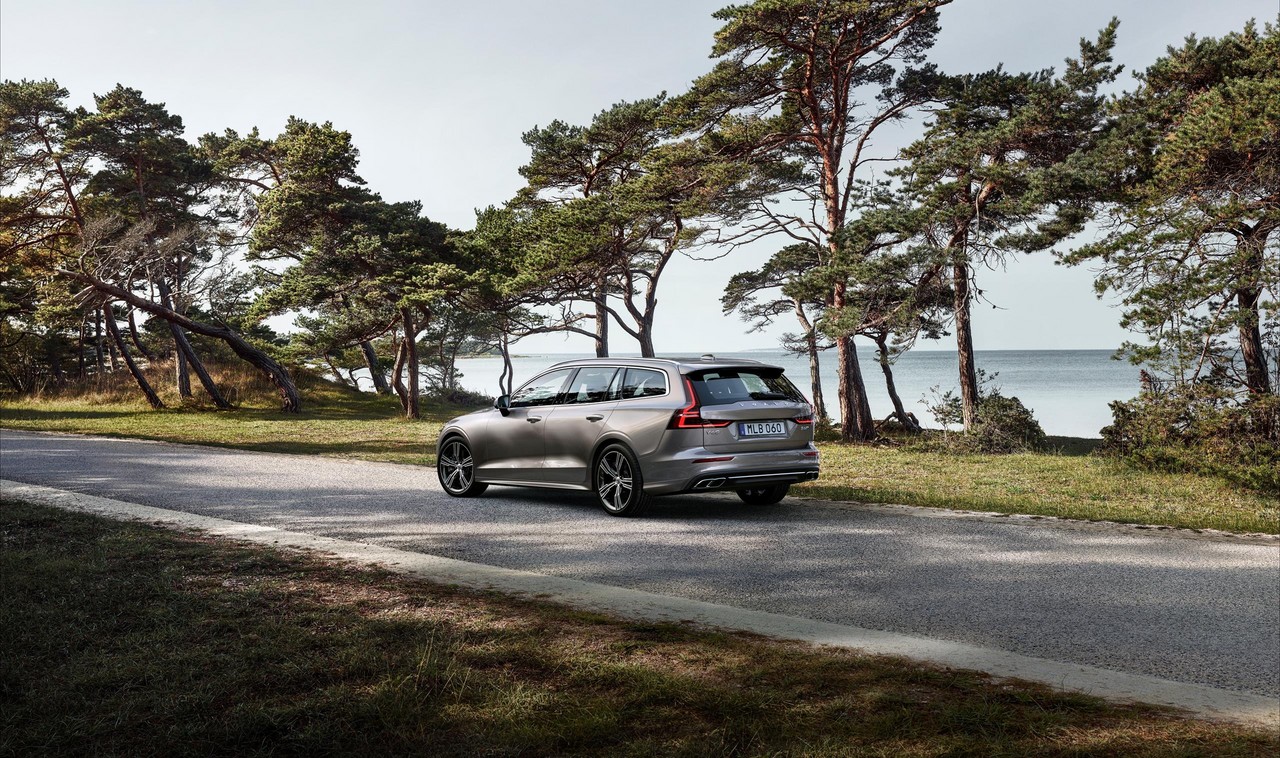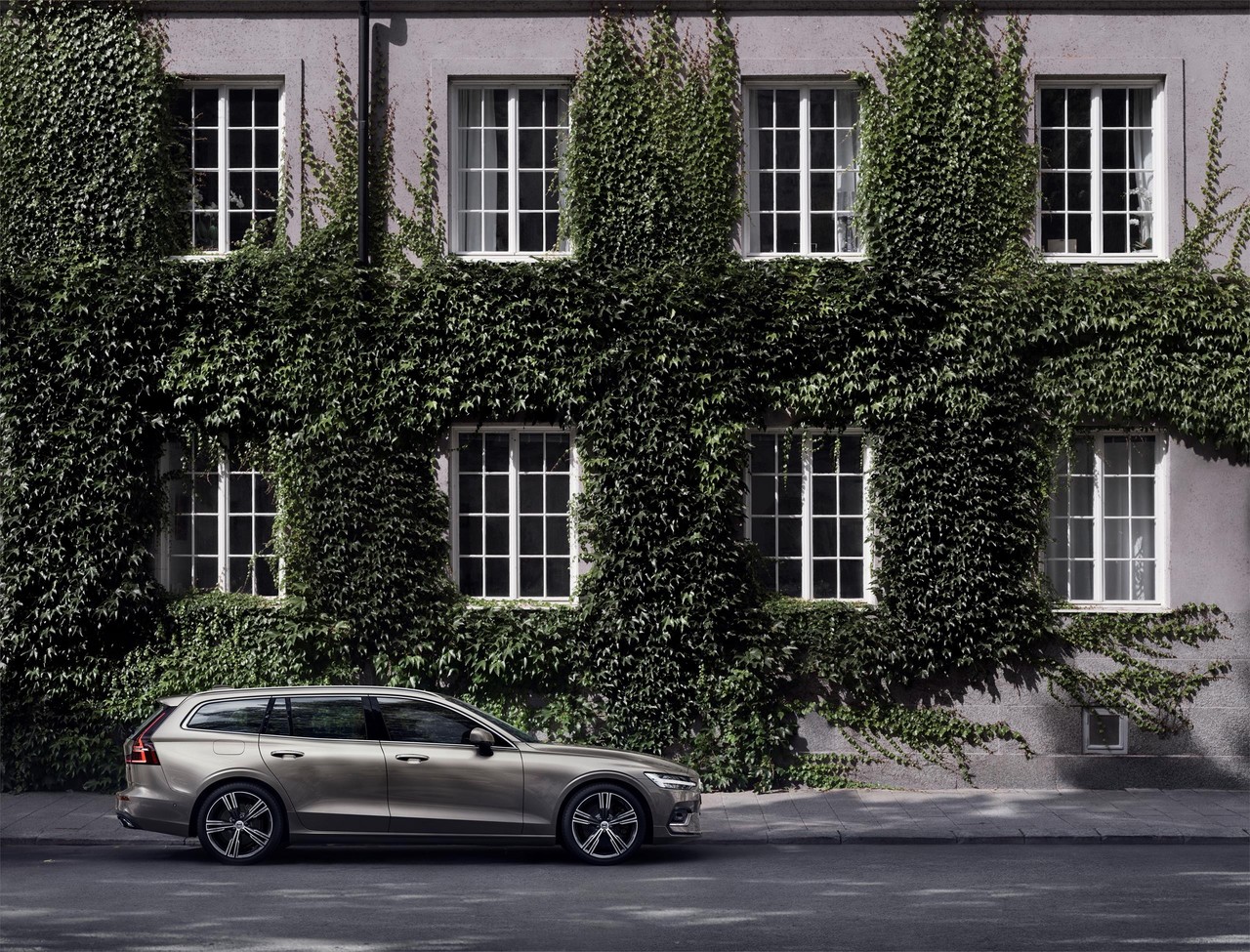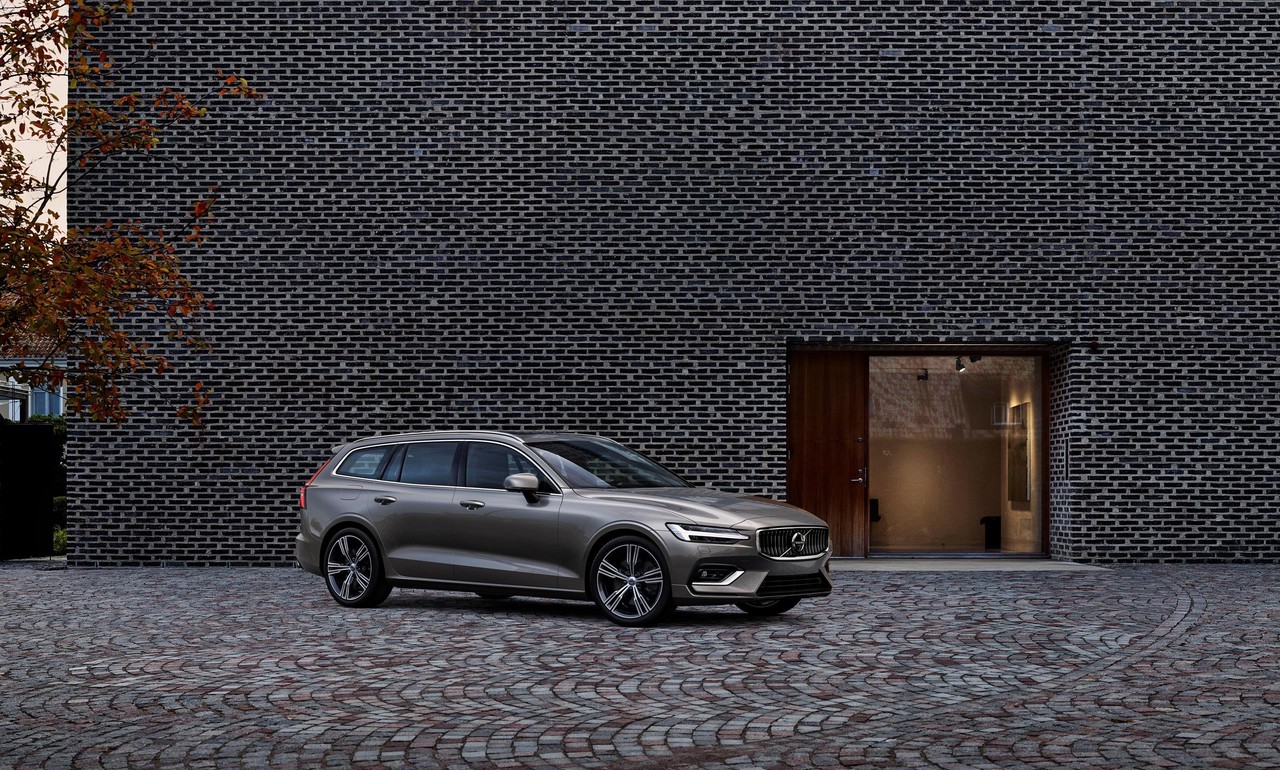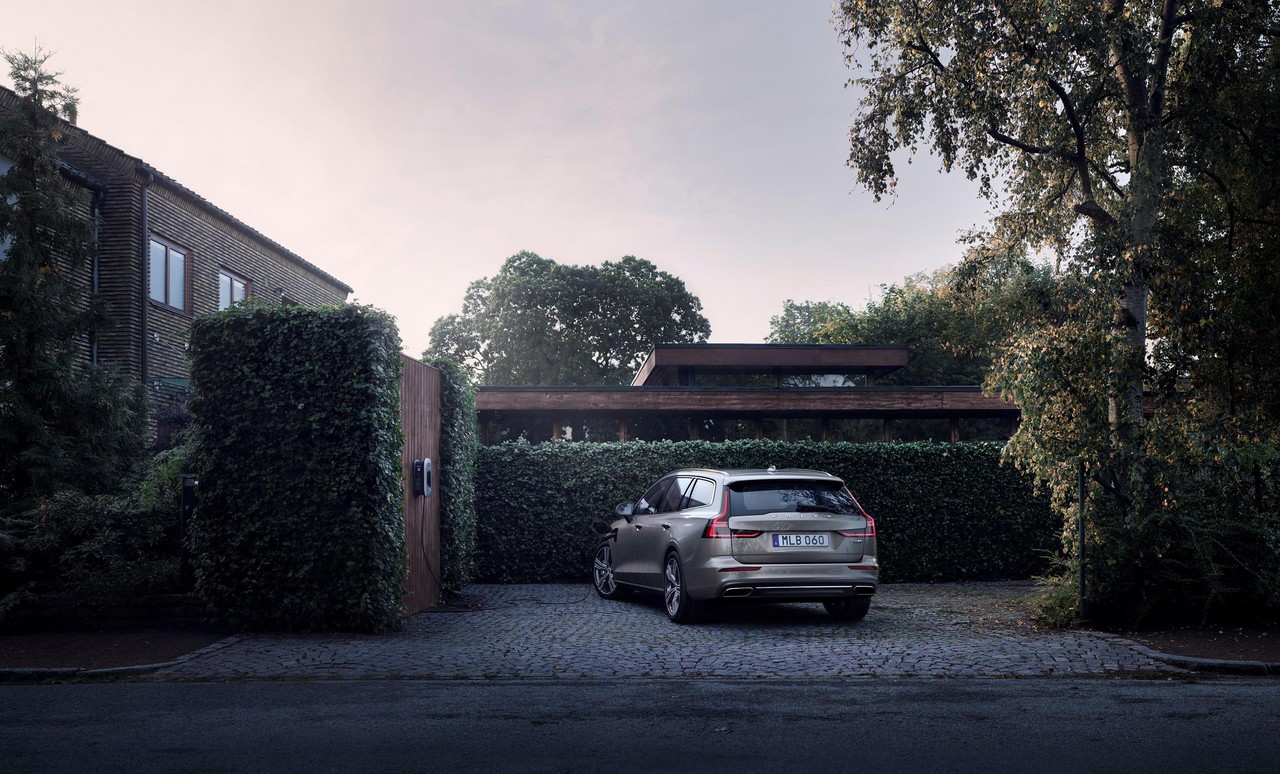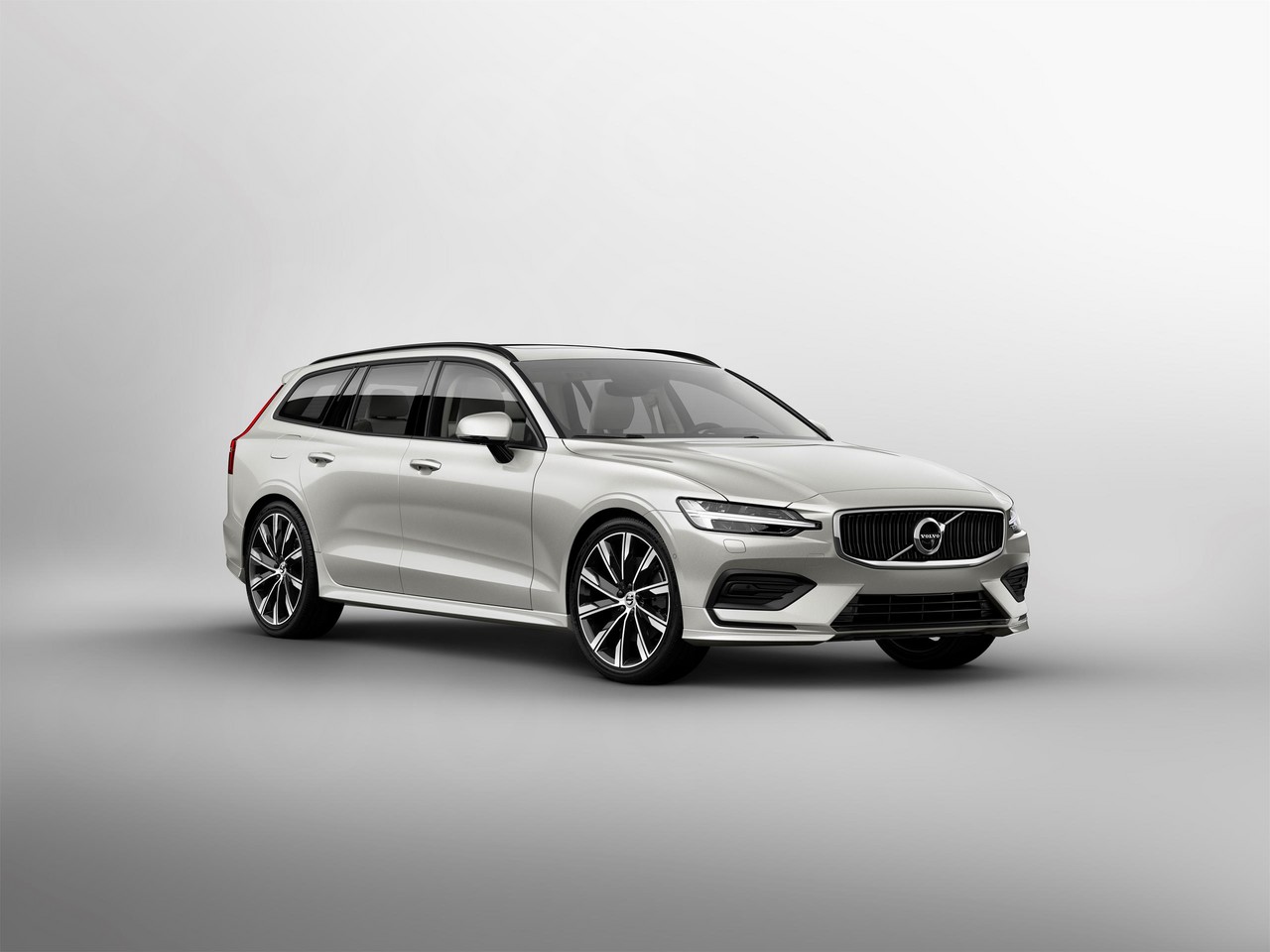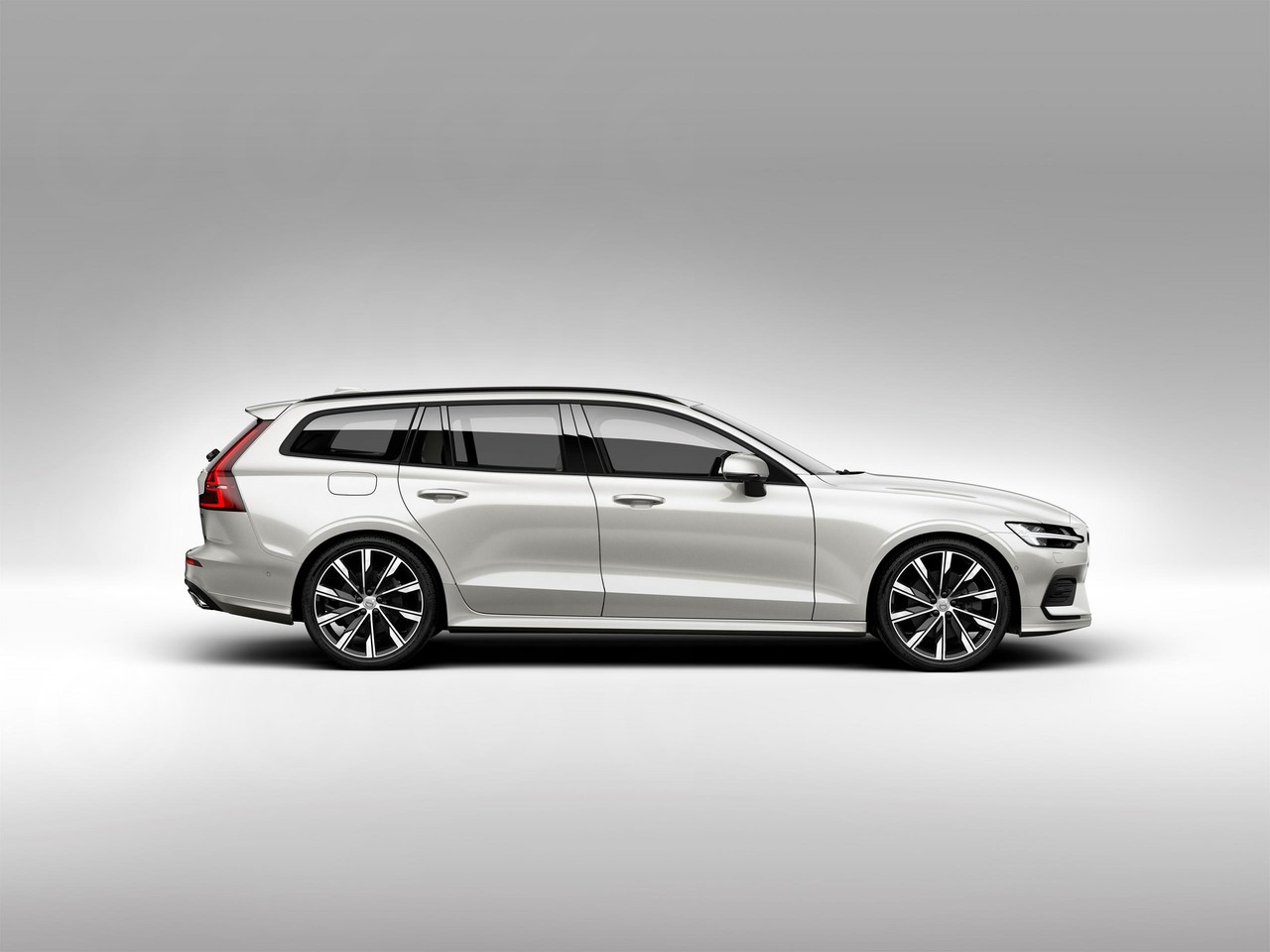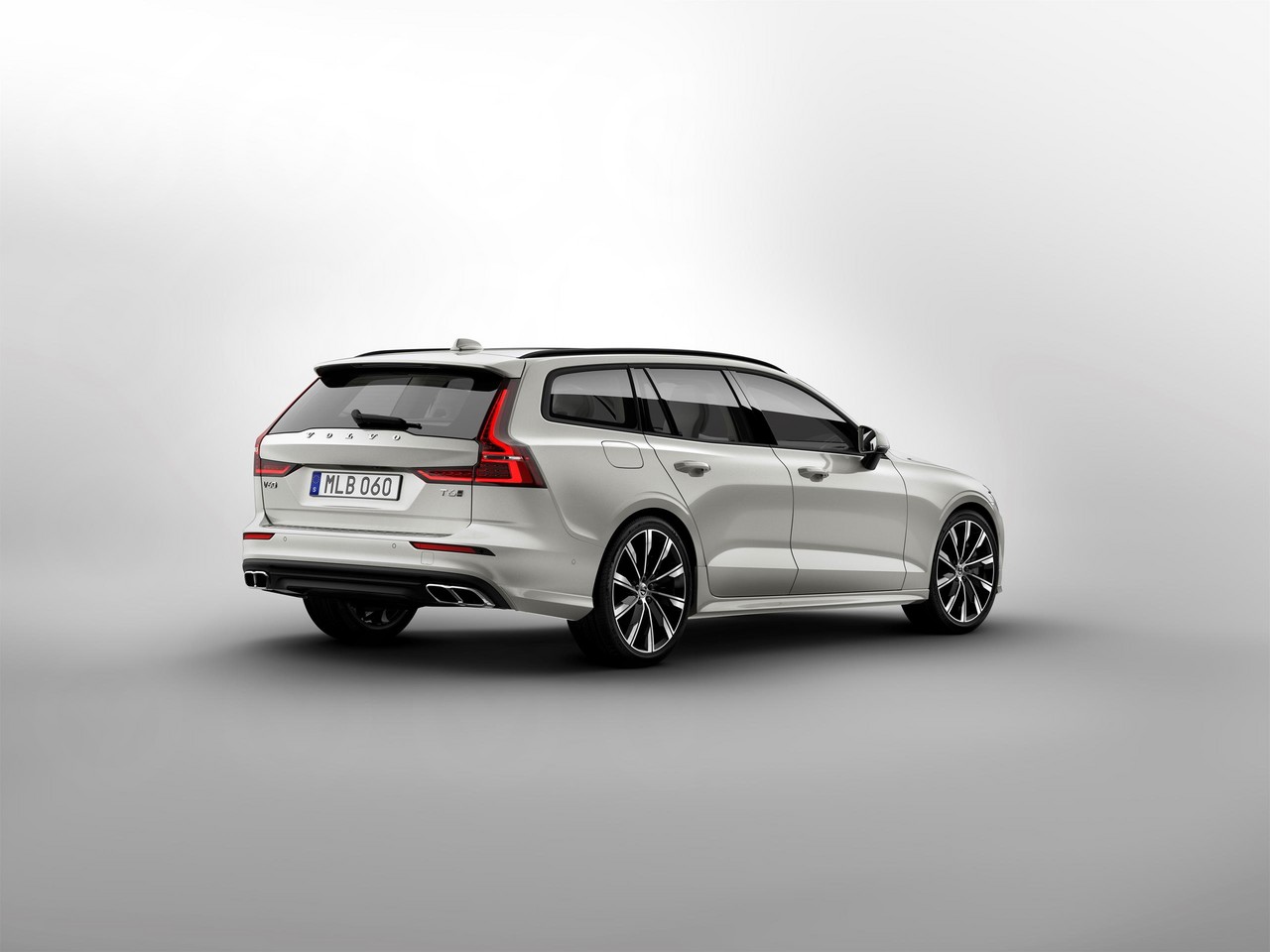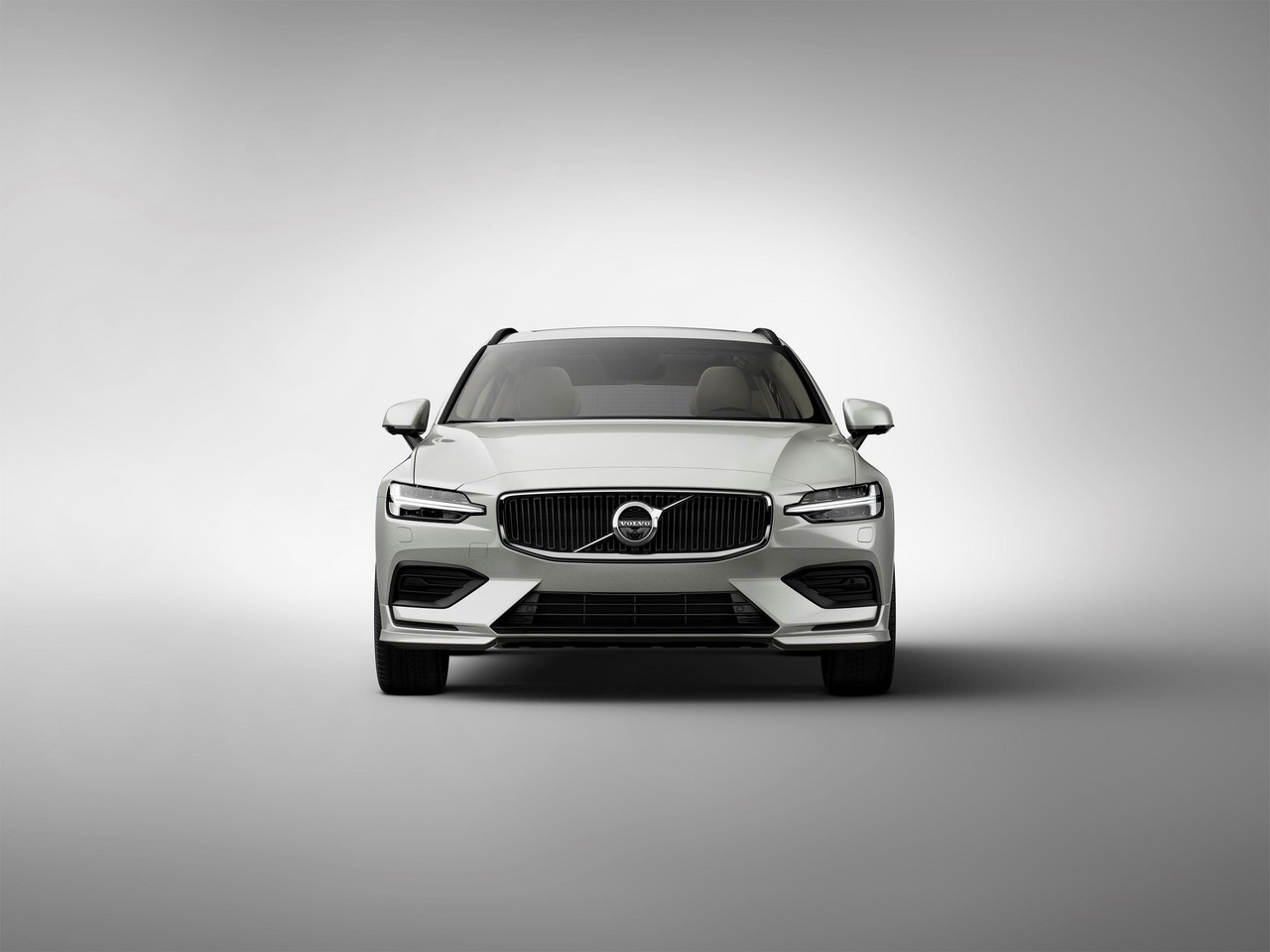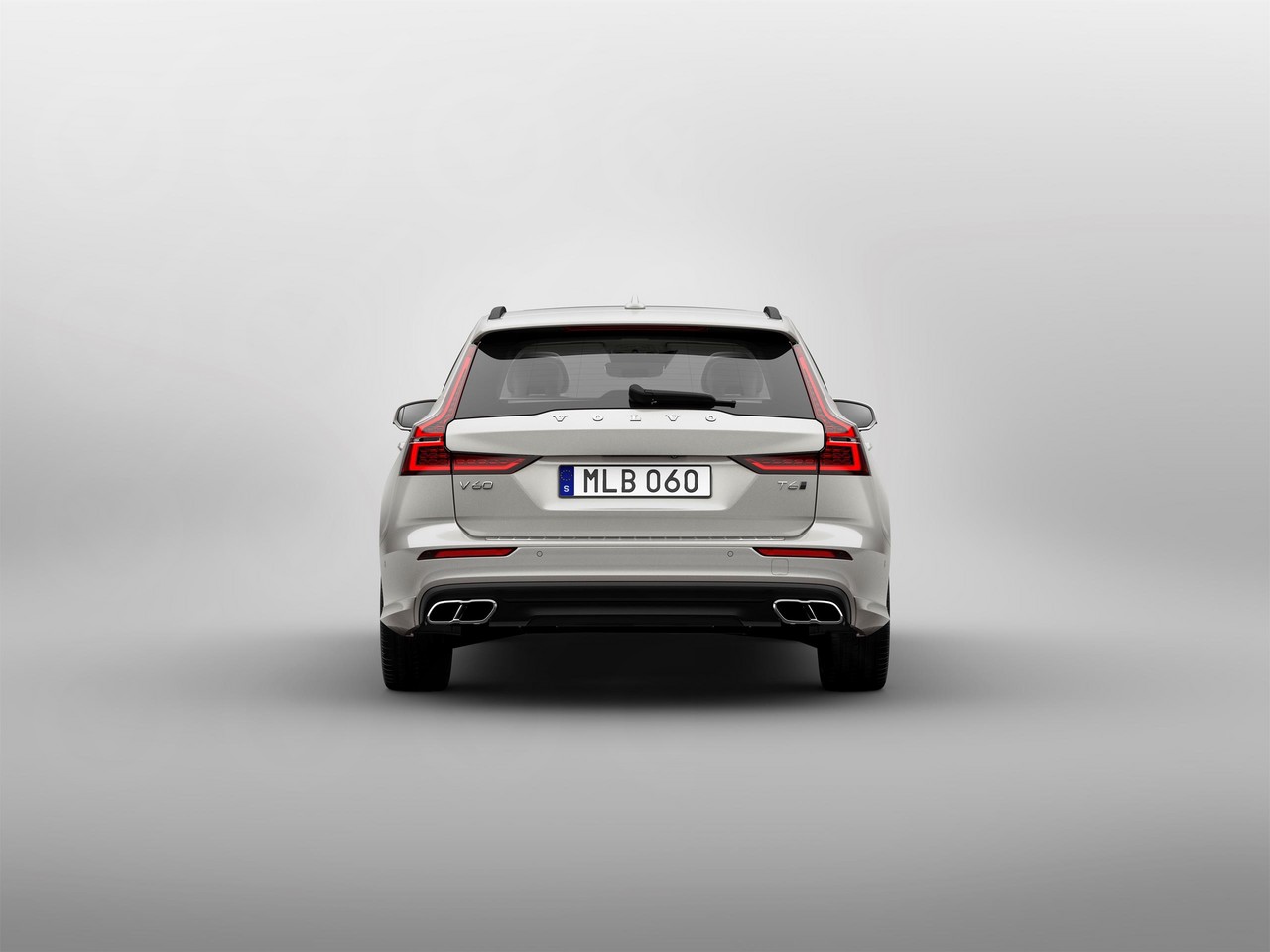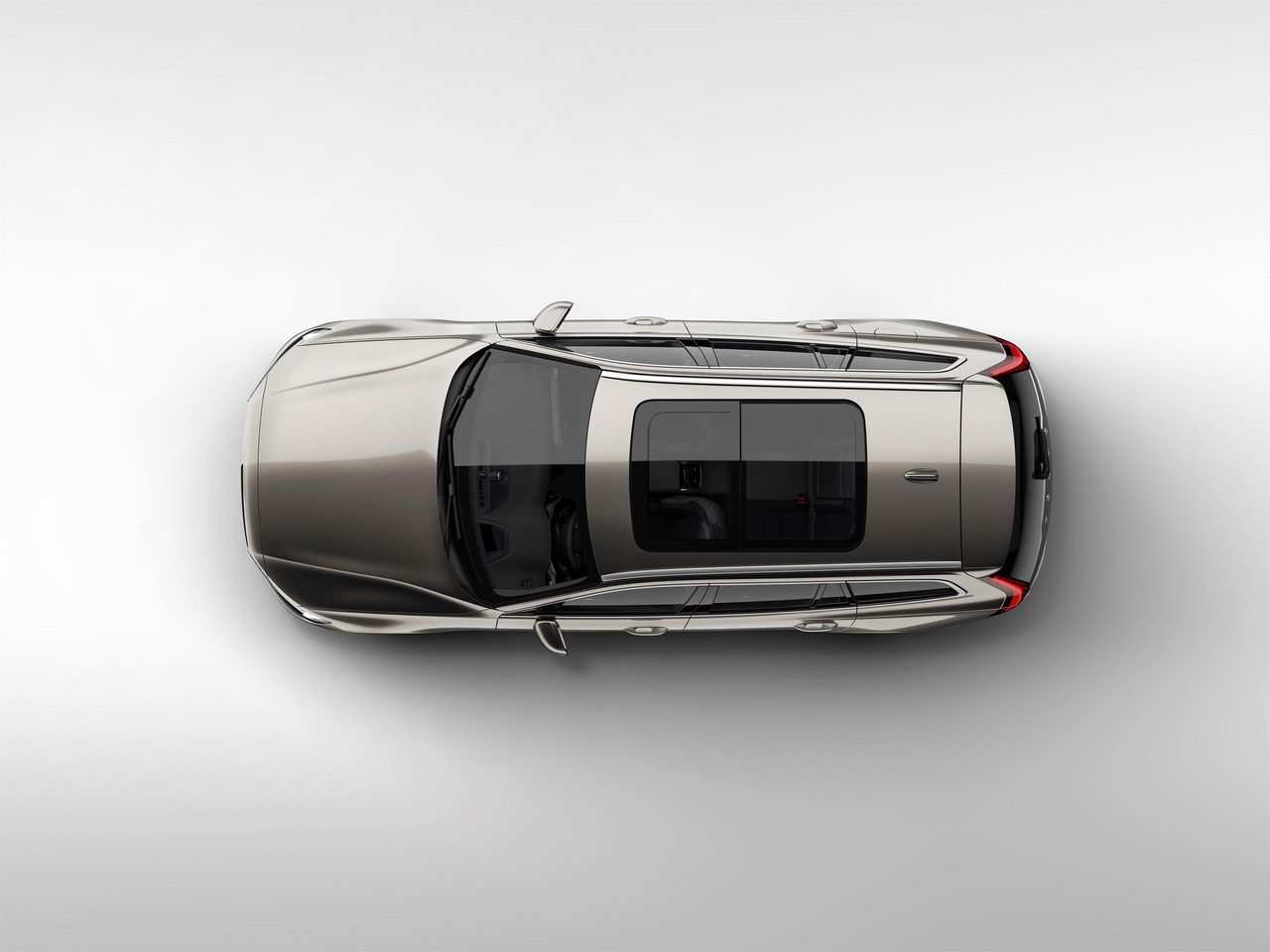
- Generally comfortable ride and good body control
- Spacious interior features soft-touch materials
- Large boot and flat loading floor
- Five star Euro NCAP safety rating
- Sensus infotainment system works well…
- … but separate air conditioning controls would be easier to use
- Tyre noise
- Noisy diesel engines
- Occasional hesitation from transmission in selecting gear
- Steering lacks feel and feedback
Overview
To be released in Australia in August 2019, the Volvo Mk.3 V60 is a mid-size wagon. Manufactured in Torslanda, Sweden, the Volvo Mk.3 V60 range for Australia will consist of T5 AWD variants (available in Momentum, Inscription and R-Design editions) and T8 Twin Engine Plug-in Hybrid variants (solely available in R-Design editions).
| Variant | Edition | Engine | Trans. | Peak power | Peak torque |
|---|---|---|---|---|---|
| T5 AWD | Momentum, Inscription |
1969 cc turbo petrol I4 | 8sp auto | 187 kW at 5500 rpm | 350 Nm at 1800-4800 rpm |
| T5 AWD | R-Design | 1969 cc turbo petrol I4 | 8sp auto | 192 kW at 5500 rpm | 400 Nm at 1800-4800 rpm |
| T8 Twin Engine AWD Plug-in Hybrid | R-Design | 1969 cc B4204T34 turbo and super charged petrol I4 | 8sp auto | 223 kW at 5700 rpm | 400 Nm at 2200-4800 rpm |
| Electric motor | 65 kW | 240 Nm | |||
| Combined | 300 kW | 640 Nm | |||
Haldex all-wheel drive (AWD) system
The Volvo V60 T5 and T8 Twin Engine variants are fitted with a fifth-generation Haldex all-wheel drive system which consists an electronically controlled and hydraulically actuated multi-plate clutch coupling (located in front of the rear axle differential at the end of the prop shaft). Under low loads or when coasting, the rear axle is decoupled to reduce fuel consumption. If, however, there is a loss of front wheel traction or such a loss is anticipated by on-board sensors, then an electrohydraulic oil pump applies pressure to the clutch plates to transfer up to 50 per cent of the engine’s torque to the rear wheels (for a 50:50 front:rear torque split).
Body and dimensions
The Volvo Mk.3 V60 is underpinned by Volvo’s ‘Scalable Product Architecture’ (SPA) which is shared with the Volvo Mk.3 S60 , Volvo Mk.2 XC60 and Volvo S90 . Compared to the Volvo Mk.2 V60 which it replaces, the Volvo Mk.3 V60 is 133 mm longer (at 4761 mm), 15 mm narrower (1850 mm), 57 mm lower (1427 mm) and has a 96 mm longer wheelbase (2872 mm); its drag co-efficient is 0.29 Cd. Furthermore, the Volvo V60 has a luggage capacity of 529 litres, though this increases to 1441 litres when the rear seats are folded down and luggage is filled to the roofline.
Suspension
The Volvo Mk.3 V60 has double wishbone front suspension with coil springs and an integral link rear axle with transverse composite leaf springs; as standard, both the front and rear suspension have hydraulic shock absorbers and stabiliser bars.
For Australian deliveries, the Volvo V60 R-Design is equipped with Volvo’s ‘Active Four-C Chassis’ which includes electronically controlled dampers that vary damping resistance according to driving conditions.
Steering
The Volvo Mk.3 V60 has rack-and-pinion steering with speed-sensitive, electric power assistance.
Safety equipment
Standard safety equipment for the Volvo Mk.3 V60 includes dual front airbags, a driver’s knee airbag, front seat-mounted side airbags, full-length curtain airbags (i.e. for front and rear occupants), ABS, electronic brake force distribution, brake assist, electronic stability control, traction control and front seatbelts with pre-tensioners and load limiters.
For the Volvo V60, Volvo’s ‘City Safety’ system is fitted as standard and active at speeds above 4 km/h. City Safety included collision avoidance or mitigation with –
- Other vehicles: for vehicles in front of the Volvo V60, the driver receives a warning followed by autonomous braking if the driver does not brake or steer to avoid the vehicle ahead. At speed differences up to 50 km/h between the V60 and the vehicle ahead, the collision can be avoided even if the driver does not react. At higher speed differences, however, the autonomous braking of the V60 only reduces the severity of the collision. If a collision is imminent and the V60 is travelling above 30 km/h, the front seatbelts are tightened;
- Cyclists: if a cyclist swerves into, crosses or is stationary in the path of the Volvo V60, City Safety warns the driver and initiates autonomous braking if the driver does not apply the brakes;
- Oncoming vehicles in intersections: if the driver turns in front of an oncoming vehicle, City Safety can assist by braking autonomously if the driver fails to do so. If a collision is imminent and the V60 is travelling above 10 km/h, the front seatbelts are tightened;
- Pedestrians: if a pedestrian moves into, crosses or is stationary in the path of the Volvo V60, the driver would be warned and the brakes would be applied autonomously if the driver fails to do so (operating at speeds up to 70 km/h). A collision with a pedestrian can be avoided at speeds of up to 45 km/h; and,
- Large animals: for the V60, the radar/camera unit can detect large animals – such as moose, elk and deer – that are either on the road or about to cross it. The driver receives an initial warning and, when braking, additional brake pressure can be provided to support avoidance if needed. If the driver does not respond, however, the brakes would be applied autonomously. According to Volvo, autonomous braking when large animals are detected could result in vehicle speed being reduced by 15 km/h. If a collision is imminent and the V60 is travelling at speeds above 30 km/h, the front seatbelts would be tightened.
For Australian-delivered vehicles, the Volvo V60 is also understood to be fitted with the following active safety technologies as standard –
- Oncoming Lane Mitigation (OLM): active at speeds between 60 km/h and 140 km/h, OLM helps drivers avoid collisions with vehicles in an oncoming lane. The system works by alerting a driver who has unintentionally departed from their lane and provides automatic steering assistance to guide them back into their lane;
- Run-Off Road Protection: if the V60 departs from the road, the front seatbelts are automatically tightened. To prevent spinal injuries, an energy-absorbing function between the seat and seat frame mechanically deforms to cushion the vertical forces that occur when a vehicle encounters a hard landing;
- Lane Keeping Aid: uses cameras to monitor the V60’s position in its lane and provides an audible warning if the V60 is about to depart from its lane without the turn indicators having been applied. The Lane Keeping Aid function can also apply corrective steering to return the V60 to the centre of its lane;
- Driver Alert Control: monitors driving behaviour for fatigue and, if detected, sounds a warning tone and displays a message encouraging the driver to take a break; and,
- Volvo’s ‘IntelliSafe Surround’ technologies:
- Blind Spot Information System (BLIS): uses rear radar sensors to detect vehicles approaching the rear of the V60 from seventy (70) metres away and would alert drivers to their presence. For the V60, BLIS includes a ‘steer assist’ function that steers the vehicle back into its lane;
- Cross Traffic Alert (CTA): rear radar sensors alert the driver to crossing traffic – up to 30 metres from the sides of the vehicle – when reversing out of a parking space; and,
- Rear Collision Mitigation: uses a rearward facing radar to detect if a rear impact is imminent and, if so, tightens the seatbelts to protect occupants and flashes the brake lights to warn the following driver.
As standard, the Volvo V60 will be equipped with Adaptive Cruise Control (ACC). When cruise control is active, ACC can automatically reduce vehicle speed if a vehicle is detected in the lane ahead and accelerate back to the cruising speed when the road ahead clears.
Pilot Assist
As standard, the Volvo Mk.3 V60 will be equipped with Volvo’s ‘Pilot Assist’ which assists with acceleration, braking and steering functions to help the driver follow the traffic flow within their lane. According to Volvo, this assistance reduces driver strain and increases safety margins by enhancing distance keeping and positioning within the lane. For the Volvo V60, the second generation Pilot Assist system provides steering assistance at speeds up to 130 km/h and does not need a vehicle ahead to follow where road markings are clearly defined.
The Pilot Assist system is limited in the extent of acceleration, braking and steering force it can apply. As such, the driver remains responsible for the operation of the vehicle and Pilot Assist would automatically switch off if the driver did not keep their hands on the steering wheel. The driver can over-ride Pilot Assist at any time by using the brake pedal, accelerator pedal or steering wheel. Furthermore, using the lane change indicator turned off steering support.
Euro NCAP testing: 2018 Volvo V60
In Euro NCAP testing , the 2018 Volvo V60 received a five star safety rating which included a 96 per cent adult occupant protection rating and an 84 per cent child occupant protection rating. In the frontal offset test, occupant protection was generally rated as good, though leg protection for the driver’s lower right and left legs was rated as adequate and marginal, respectively (i.e. a slight and moderate risk of serious injury). While maximum points were awarded in the side impact test, chest protection for the driver in the more severe pole test was rated as adequate.
Features: Volvo V60 Momentum
The standard infotainment system for the Volvo V60 consists of a 330 watt audio system with ten speakers, digital radio tuner (DAB), a navigation system with a 9.0-inch display, auxiliary (3.5 mm) and USB inputs, smartphone integration via USB (iPhone and Android), Bluetooth mobile phone connectivity and audio streaming.
Beyond this, standard features for the Volvo V60 Momentum include 17-inch black diamond-cut alloy wheels, power adjustable front seats with driver’s seat memory settings, leather upholstery, dual-zone climate control air conditioning, LED headlights with integrated high pressure cleaners and Volvo’s ‘Active High Beam’ (i.e. automatic switching between low and high beam), front fog lights, dusk-sensing headlights, rain-sensing wipers, front and rear parking sensors, a rear view camera, 60/40 split folding rear seats, remote central locking with proximity key, power adjustable and heated door mirrors with folding function, power windows, a height and reach adjustable steering column, push-button start, an electric parking brake, 12 volt power sockets (in the front and rear consoles), illuminated vanity mirrors, hands-free tailgate operation (responds to foot movements), indirect tyre pressure monitoring, a trip computer, an alarm and immobiliser.
Features: Volvo V60 Inscription
Compared to the V60 Momentum, the Volvo V60 Inscription is further equipped with 19-inch black diamond-cut alloy wheels, power-operated front seat cushion extensions, heated front seats, four-zone climate control air conditioning, head-up display, directional LED headlights, interior ambient lighting and ‘Driftwood’ interior inlays.
As standard, the Volvo V60 Inscription and R-Design are also equipped with:
- Park Assist Pilot: provides automated steering for parallel and perpendicular parking manoeuvres while the driver controls vehicle speed; and,
- Virtual Park Assist 360°: during low speed manoeuvres, Virtual Park Assist 360° uses four cameras to display a bird’s eye view of the vehicle on the central touchscreen.
Features: Volvo V60 R-Design
Relative to the V60 Inscription, the Volvo V60 R-Design is distinguished by its 19-inch matt black diamond-cut alloy wheels, R-Design sports seats, steering wheel gearshift paddles, ‘Metal Mesh’ interior inlays and 230 volt power outlet in the tunnel console.
